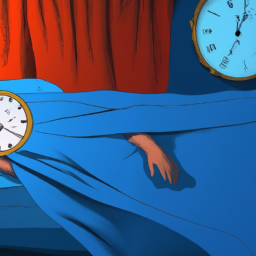Dream Meaning
How Long Do Dreams Last

As a person who has consistently been captivated by the intricate functions of the human brain, I frequently find myself contemplating the enigmas surrounding sleep and dreams.
How is it that we can slip so effortlessly into another world while we slumber? And just how long do those dreams actually last?
To answer these questions, we must first understand the different stages of sleep and their relationship to dreaming.
As our bodies rest and recharge during the night, our brains cycle through several distinct phases of sleep, each with its own unique characteristics and functions.
In this article, we will explore the science behind these stages and delve into the fascinating world of dreams – from their duration to common themes and even how they relate to mental health.
So join me as we dive deeper into this mysterious realm of human consciousness!
Key Takeaways
- Most dreams typically last between five and twenty minutes.
- Factors such as age, medication use, and alcohol consumption can affect dream duration.
- Poor sleep quality can result in shorter dream periods or no dreams at all.
- The most vivid and memorable dreams occur during REM sleep.
Explanation of Sleep Stages
Let’s dive into the fascinating world of sleep stages, where dreams can last anywhere from a few seconds to up to 20 minutes. Our brains cycle through two main types of sleep: rapid eye movement (REM) and non-rapid eye movement (NREM).
NREM is further divided into three stages. During NREM stage one, we’re in light sleep and may experience sudden muscle contractions or hypnic jerks. In stage two, our brain waves slow down, and body temperature drops. Finally, during stage three, we enter deep sleep where it’s difficult to wake us up.
During REM sleep, our eyes move rapidly back and forth behind closed eyelids as if watching a movie. The rest of our body becomes paralyzed to prevent us from acting out our dreams. Interestingly enough, most dreaming occurs during this stage, which usually happens about 90 minutes after falling asleep and recurs every 90-120 minutes throughout the night.
As we go through multiple cycles of NREM and REM sleep, the duration of each cycle changes with more time spent in REM towards morning. Sleep cycle patterns vary among individuals but generally follow a predictable pattern that alternates between NREM and REM phases throughout the night.
Understanding these stages helps us better comprehend how long dreams can last since they occur primarily during REM sleep, when the brain is highly active despite being physically still. With that said, let’s explore how dreams fit into the bigger picture of our sleeping habits without missing a beat!
The Relationship Between Dreams and Sleep
As we drift off into slumber, our minds transport us to a realm of endless possibilities and surreal scenarios. This is where dreams take place a phenomenon that has puzzled scientists for decades.
The exact relationship between dreaming and sleep is still not well understood, but researchers have been able to uncover some insights. One important aspect of dreaming is its role in memory consolidation. Dreams allow the brain to process and organize information obtained during waking hours, which can improve overall cognitive function. Additionally, studies have shown that dreams may help with problem-solving by allowing the mind to explore different solutions without the limitations of reality.
The most vivid and memorable dreams occur during Rapid Eye Movement (REM) sleep. This stage of sleep is characterized by rapid eye movements, shallow breathing, and increased brain activity. It’s believed that REM sleep plays a crucial role in emotional regulation and learning processes. As such, it’s no surprise that many theories suggest a strong link between dreams and REM sleep.
Dreams are an integral part of the human experience that continue to fascinate scientists and laypeople alike. By exploring their relationship with memory consolidation and the role of REM sleep in dreaming, researchers have made significant progress towards understanding this enigmatic phenomenon.
But now let’s move on to the next question how long do these imaginative excursions actually last?
How Long Do Dreams Actually Last?
The duration of our imaginative excursions during sleep can offer insights into the complexity and depth of our subconscious minds. Dreams have fascinated scientists for centuries, yet we still don’t fully understand their purpose or how they work.
One aspect that researchers have been able to study is dream duration. The science behind dream duration reveals that dreams typically last between five and twenty minutes, although they can be as short as a few seconds or as long as an hour. The length of a dream depends on which stage of sleep it occurs in, with most dreaming happening during Rapid Eye Movement (REM) sleep.
During REM sleep, the brain is highly active and processes information from the day while also creating vivid images and storylines. The impact of the REM cycle on dreams means that some people may experience longer dreams than others depending on their sleeping patterns.
Factors such as age, medication use, and alcohol consumption can also affect dream duration. Understanding these factors can provide us with greater insight into how our brains function during sleep and what influences our subconscious thoughts and experiences.
Factors That Affect Dream Duration
Factors like age, medication, and alcohol intake can impact how long our nighttime fantasies continue as they’re mainly influenced by the REM cycle.
Certain medications can affect the duration of our dreams by suppressing or enhancing the REM stage. For example, antidepressants are known to decrease the amount of time spent in REM sleep, which could lead to shorter dream periods.
Sleep quality also plays a crucial role in determining how long we dream for. Poor sleep quality means that we may not spend enough time in the REM stage of sleep, which is when most dreaming occurs. This could result in shorter dream periods or even no dreams at all. On the other hand, getting enough high-quality sleep can lead to longer and more vivid dreams.
It’s important to note that factors affecting dream duration are highly subjective and vary from person to person. What works for one individual may not work for another due to differences in physiology and lifestyle choices.
Understanding these factors can help improve our overall sleep quality and ultimately enhance our dreaming experience. Moving forward, let’s explore common themes found in dreams and how they relate to our daily lives.
Common Themes in Dreams
As a dream researcher, I find it fascinating to explore the common themes that people experience in their dreams.
Falling, flying, and being chased are some of the most prevalent motifs that appear across cultures and age groups. These themes often reflect our subconscious fears and desires, such as loss of control or seeking freedom.
By studying these recurring patterns in dreams, we can gain insight into the human psyche and how our minds process emotions during sleep.
Falling
Have you ever had that feeling of falling in a dream and it seems to last forever? Falling dreams are one of the most common types of dreams, and they often leave us feeling uneasy or scared. These dreams can occur during any stage of sleep, but they typically happen during the rapid eye movement (REM) phase.
Falling dreams can be interpreted in many ways through dream symbolism; some believe that they represent a loss of control or powerlessness in our waking life. Despite how real falling dreams may seem, they actually don’t last very long. Studies have shown that most dreams, including falling dreams, only last for a few seconds to a few minutes.
However, because our brain processes time differently during dreaming versus waking life, it can feel like we’re falling for much longer than we actually are.
Now let’s transition into talking about flying in dreams without missing a beat!
Flying
Flying in dreams is a thrilling experience that can make us feel free and empowered. Lucid dreaming techniques, such as reality checks and keeping a dream journal, can increase the likelihood of having flying experiences in dreams.
During these experiences, our brains create vivid sensations of wind rushing past our faces and the sensation of weightlessness as we soar through the air. Some people report feeling more confident and capable after having a flying dream, which may be due to the sense of control they feel while in flight.
However, it’s important to note that not everyone experiences flying dreams or lucid dreaming techniques in the same way. As we explore different dream scenarios like being chased, we may find that certain techniques work better for some individuals than others.
Being Chased
Flying dreams may be exhilarating, but being chased in a dream can evoke feelings of anxiety and fear. When I’m being pursued in my dreams, it feels like the predator is closing in on me with every step.
My heart races, and my body tenses up as I try to run away or hide. But why do we have these intense dreams of being chased?
Psychological effects play a significant role in our dream experiences. Being chased can represent a feeling of being overwhelmed or pursued by something that we can’t escape from in our waking life. Our subconscious mind uses these scenarios to process unresolved emotions and fears that we may not even be aware of consciously.
Additionally, cultural interpretations also impact the content of our dreams. For example, some cultures believe that dreaming about being chased signifies impending danger or an upcoming obstacle that needs to be overcome.
Three common themes that appear when dreaming about being chased are: feeling trapped or cornered, being unable to move quickly enough, and having no control over the situation.
Understanding these themes and interpreting them can help us identify hidden anxieties and concerns that need attention in our waking life.
In the next section, we’ll explore how lucid dreaming can give us more control over our dream experiences.
Lucid Dreaming
If you’re looking for a way to take control of your dreams, lucid dreaming is an exciting and rewarding experience. Lucid dreaming is the ability to be aware that you are in a dream state, allowing you to manipulate the dream environment and control your actions within the dream. There are various techniques that can help induce lucid dreaming, such as reality testing and keeping a dream journal.
Reality testing involves checking whether you are awake or asleep by asking yourself questions throughout the day, such as “am I dreaming?”This habit will eventually carry over into your dreams, where you may become aware that you are in a dream state. Keeping a dream journal can also aid in achieving lucid dreams by helping to identify common themes or patterns in your dreams.
Once you have achieved lucidity in a dream, there are various methods for controlling the outcome of the dream. One popular technique is known as ‘dream spinning’, which involves spinning around in circles within the dream world to change its scenery or setting. Another method is known as ‘lucid summoning’, where one can bring objects or characters into existence simply by focusing on them.
Lucid dreaming can be an incredible tool for personal growth and self-discovery. However, it’s important to note that like any skill, it takes practice and patience to master. In order to fully harness its potential benefits, one must be willing to commit time and effort towards developing their ability to control their dreams.
As much as we desire pleasurable experiences during our sleep hours through lucid dreaming, sometimes nightmares could overshadow our efforts. Nightmares could come from various sources; some people suffer from post-traumatic stress disorder (PTSD) nightmares while others have recurrent nightmare disorder (RND). It’s essential for individuals who frequently experience bad dreams affecting mental health seek professional assistance from therapists specialized in treating sleep disorders.
Nightmares
You might find yourself jolting awake in the middle of the night, sweating profusely and your heart racing after experiencing a terrifying nightmare. Nightmares are vivid dreams that can cause intense fear, anxiety, and distress. They usually occur during REM sleep and can last anywhere from a few seconds to several minutes.
Coping mechanisms for nightmares include practicing relaxation techniques before bed such as deep breathing or meditation. It’s also helpful to establish a regular sleep schedule and avoid consuming alcohol or caffeine before bedtime. In some cases, therapy may be necessary if nightmares are frequent or severe enough to affect mental health.
The effects of nightmares on mental health can vary depending on the individual’s coping mechanisms and support system. For some people, frequent nightmares can lead to symptoms of anxiety or depression. However, with proper treatment and coping strategies in place, individuals can learn to manage their nighttime fears and reduce the negative impact on their overall well-being.
Interpreting dreams is often seen as a way to gain insight into one’s subconscious thoughts and emotions.
Dream Interpretation
When interpreting your dreams, try to tap into the hidden meanings and messages behind the symbolism presented in your subconscious state. Dreams are full of symbolic representation that can be interpreted in various ways. Dream analysis is a process of understanding those symbols and their implications on our conscious life. Here are five factors to consider when interpreting your dreams:
- Context: Consider what was happening before the dream started and what happened after it ended.
- Emotions: Pay attention to how you felt during the dream and how you feel about it now.
- Symbols: Identify any recurring themes or objects that appeared in the dream.
- Personal experiences: Think about any personal experiences related to the symbols present in your dream.
- Culture & society: Consider how cultural and societal norms may have influenced your dream.
By analyzing these factors, we can uncover hidden meanings within our dreams that may be relevant to our waking life. Dream interpretation can provide insight into our innermost thoughts, fears, desires, and hopes. Understanding ourselves through our dreams can lead to greater self-awareness and personal growth.
Understanding the relationship between dreams and mental health is crucial for wellbeing. Dreams can be a reflection of our mental state, whether positive or negative. They may reveal underlying stressors or emotional conflicts that need attention. By paying attention to our dreams, we can identify potential issues early on and take steps towards resolving them before they impact our mental health negatively.
The Relationship Between Dreams and Mental Health
Understanding the relationship between dreams and mental health is crucial for maintaining overall wellbeing, as they can provide insight into our subconscious state and reveal underlying stressors or emotional conflicts. Dreams are a natural part of the human experience, but their significance goes beyond just being a series of random events that occur during sleep. In fact, research has shown that dreams have a significant impact on our emotional and cognitive processing.
One function of dreams is to help regulate our emotions. Dreams often reflect our emotional states and can serve as a way to process difficult emotions or experiences. For example, if someone is struggling with anxiety, they may have recurring nightmares about the situations that trigger their anxiety. While these nightmares may be unpleasant, they provide an opportunity for the individual to confront and process their fears in a safe environment.
Additionally, dreams play an important role in cognitive processing. During sleep, our brains continue to process information from the day before, including memories and new learning. Dreams can help consolidate this information by integrating it into existing knowledge structures in the brain. This means that dreaming can potentially enhance memory retention and improve problem-solving abilities.
Overall, understanding the connection between dreams and mental health underscores how essential it is to prioritize quality sleep habits as part of self-care practices. By paying attention to dream content and patterns over time, individuals may be able to identify areas of stress or conflict in their lives that require further attention or support from mental health professionals.
Frequently Asked Questions
Can dreaming ever be harmful to our mental health?
Dream interpretation and nightmare prevention are important for mental health. While dreams themselves can’t harm us, the emotions they evoke may impact our mood. It’s crucial to actively work on interpreting and preventing negative dreams to promote positive mental well-being.
Why do some people remember their dreams more vividly than others?
As a researcher, I’ve found that memory processing and sleep quality play a significant role in dream recall. Those with better memory and more restful sleep cycles tend to remember their dreams more vividly.
Is it possible for a dream to last for hours or even days?
Dreams can last from a few seconds to 30 minutes. During REM sleep, the stage where most dreaming occurs, dreams can become more vivid and complex. However, it is not possible for dreams to last for hours or days.
Do animals dream like humans do?
Animal dream research suggests that many species dream, including mammals, birds and reptiles. However, it is difficult to interpret dreams in animals as we cannot ask them about their experiences or thoughts during sleep.
Can lucid dreaming be used as a form of therapy?
Lucid dreaming can be used as a form of therapy due to its benefits in reducing anxiety, PTSD, and nightmares. Techniques such as reality checks and keeping a dream journal can increase the likelihood of achieving lucidity.
Conclusion
In conclusion, the duration of dreams is dependent on various factors such as sleep stage and individual differences. Dreams can last anywhere from a few seconds to 30 minutes, and they occur most frequently during the rapid eye movement stage of sleep.
However, it’s important to note that while dreams may seem like they last for hours, they mostly occur during short time periods. While some people may experience lucid dreaming or nightmares, others may have recurring themes in their dreams.
Dream interpretation can be useful in understanding one’s subconscious thoughts and emotions. Furthermore, research has shown that there is a relationship between dreaming and mental health, with an increase in dream activity associated with certain psychiatric disorders.
Overall, although we spend a third of our lives sleeping and dreaming, much remains unknown about this fascinating phenomenon. While science continues to unravel the mysteries of the human mind during sleep, our dreams continue to provide us with insight into ourselves and our deepest desires.
Manda is the visionary Editor in Chief of Hello Lovely. With an unwavering passion for dreams, Manda ensures that our content is meticulously curated, informative, and engaging.
Their dedication to providing high-quality articles, guides, and resources is evident in the wealth of information available on our platform. Manda’s expertise in dream research, combined with their editorial prowess, helps shape Hello Lovely into a trusted source of dream-related knowledge. Their goal is to create a vibrant dream-centric community where individuals can explore, learn, and connect.
Dream Meaning
What Is Barefoot Dreams Made Of

As a new mother, I was always searching for the softest and most comfortable baby clothes and blankets. That’s when I discovered Barefoot Dreams, a brand famous for its luxurious and cozy products.
But what exactly is Barefoot Dreams made of? I did some research and discovered the materials that make up their products, as well as the benefits of using them. Barefoot Dreams uses a variety of materials in their products, including microfiber, bamboo, and cashmere.
Their signature material is CozyChic, a blend of nylon and rayon that is known for its softness and durability. Other materials used include cotton, modal, and polyester. Each material has its own unique properties and benefits, and together they create the ultimate cozy experience.
In this article, I’ll dive deeper into the materials used in Barefoot Dreams products and why they make them so special.
Key Takeaways
- Barefoot Dreams uses a variety of high-quality materials in their products, including CozyChic, bamboo, cashmere, cotton, modal, nylon, and polyester.
- The signature material used is CozyChic, which is known for its softness and durability.
- The materials used in Barefoot Dreams products provide numerous benefits for skin and overall health, such as being hypoallergenic, moisture-wicking, and antibacterial.
- Barefoot Dreams uses sustainable materials and production processes to minimize their environmental impact.
Overview of Barefoot Dreams
You’re probably wondering what Barefoot Dreams is all about, so let me give you a quick overview.
Barefoot Dreams is a luxury brand that specializes in creating cozy, soft, and comfortable clothing and home goods. Their products range from blankets and throws to robes and lounge wear, and they are known for their high-quality materials and attention to detail.
What sets Barefoot Dreams apart from other brands is their commitment to using only the finest materials in their products. They use a variety of materials, including their signature CozyChic fabric, which is a blend of nylon and rayon from bamboo. Other materials used include cashmere, cotton, and microfiber.
These materials are carefully chosen for their softness, durability, and breathability, making Barefoot Dreams products the perfect addition to any cozy night in.
Materials Used in Barefoot Dreams Products
Feel the softness of clouds against your skin with our Barefoot Dreams products, crafted from the finest materials such as cashmere and bamboo.
These luxurious materials not only provide a cozy feel but also offer a range of benefits. Cashmere is known for its warmth and insulation, making it perfect for colder climates. It’s also hypoallergenic, making it suitable for those with sensitive skin.
On the other hand, bamboo is a sustainable and eco-friendly material that’s incredibly soft and breathable, making it perfect for all seasons.
Using these high-quality materials in our products ensures that our customers get the best possible experience. The softness and warmth of cashmere combined with the breathability and sustainability of bamboo make for a winning combination.
Our commitment to using only the finest materials is what sets Barefoot Dreams apart from other brands.
In the next section, we’ll discuss the benefits of using these materials in more detail.
Benefits of Using These Materials
Get ready to experience the ultimate comfort and sustainability with Barefoot Dreams products, as they offer numerous benefits from the high-quality materials used.
The brand uses a variety of materials such as bamboo, nylon, and microfiber to create their luxurious products. Bamboo is a highly sustainable material that’s naturally hypoallergenic, moisture-wicking, and breathable. Nylon is a strong and durable material that provides a soft and silky texture. Microfiber is a synthetic material that’s known for its absorbency and quick-drying properties.
These materials not only offer exceptional comfort but also have various benefits for your skin and overall health. Bamboo is gentle on sensitive skin and has antibacterial properties that prevent odor-causing bacteria from forming. Nylon and microfiber are both easy to care for and retain their shape and softness even after multiple washes.
With these materials, Barefoot Dreams products provide a long-lasting and sustainable solution for your comfort needs. This is what makes Barefoot Dreams products special and unique.
What Makes Barefoot Dreams Products Special
Experience the ultimate luxury and comfort with what sets Barefoot Dreams products apart from others. Here are five reasons why Barefoot Dreams products are special:
-
Our products are made from the softest materials, such as cozy chenille, plush microfiber, and warm wool.
-
We pay attention to every detail in the design process, ensuring that our products are not only comfortable but also stylish.
-
Our products are versatile and can be used for a variety of purposes, such as lounging at home, traveling, or even for a night out.
-
We use sustainable materials and production processes to minimize our environmental impact.
-
Our products are long-lasting and durable, ensuring that you can enjoy your Barefoot Dreams purchase for years to come.
Taking care of your Barefoot Dreams products is easy. Simply follow the care instructions on the label and avoid using harsh detergents or bleach.
With proper care, your Barefoot Dreams product will continue to provide you with the ultimate luxury and comfort.
How to Care for Barefoot Dreams Products
Taking care of your Barefoot Dreams products is essential to ensure their longevity and maintain their ultimate luxury and comfort. While these products are made of high-quality materials, proper care is still necessary to keep them in excellent condition. Here are some tips to help you care for your Barefoot Dreams products:
-
Wash your Barefoot Dreams products separately from other clothing items to prevent snagging or damage. Use a mild detergent and cold water to avoid shrinkage, and avoid using fabric softeners as they can leave a residue that can reduce the softness of your Barefoot Dreams products.
-
Air-dry your Barefoot Dreams products by laying them flat on a clean towel. Avoid hanging them as this can cause stretching and potential damage to the fabric.
-
Store your Barefoot Dreams products in a cool, dry place away from direct sunlight. This will help prevent discoloration and damage to the fabric.
By following these simple care instructions, you can ensure that your Barefoot Dreams products remain soft, luxurious, and cozy for years to come. Invest in proper care to enjoy these products for a long time.
| Emotion | Description | Example | ||||
|---|---|---|---|---|---|---|
| Comfort | Barefoot Dreams products are made of high-quality materials that provide the ultimate comfort. | "I love wrapping myself in my Barefoot Dreams blanket on a chilly night." | ||||
| Luxury | The luxurious feel of Barefoot Dreams products is unmatched. | "I feel like a queen when I wear my Barefoot Dreams robe after a long day." | ||||
| Longevity | Proper care can help extend the life of Barefoot Dreams products. | "I’ve had my Barefoot Dreams throw for years, and it still looks and feels as good as new." | ||||
| Quality | The quality of Barefoot Dreams products is evident in their softness and durability. | "I can’t believe how soft and cozy my Barefoot Dreams socks are, and they’ve held up well after multiple washes." | ||||
| Relaxation | Barefoot Dreams products evoke a sense of relaxation and comfort. | "I love snuggling up with my Barefoot Dreams pillow after a stressful day." | Overall quality | Barefoot Dreams products are known for their high-quality materials and attention to detail. | ‘I’ve never been disappointed with a Barefoot Dreams purchase – the craftsmanship is always top-notch.’ |
Frequently Asked Questions
Where can I buy Barefoot Dreams products?
I discovered Barefoot Dreams when a friend raved about their cozy blankets. Since then, I’ve been hooked on their products. You can buy them online at Nordstrom, Amazon, and their own website.
Are Barefoot Dreams products eco-friendly?
I’m not sure if Barefoot Dreams products are eco-friendly. I recommend checking their website or contacting their customer service for more information on their materials and production processes.
What is the price range of Barefoot Dreams products?
I love Barefoot Dreams products! The price range varies depending on the item, but they offer everything from cozy blankets to stylish apparel. Check their website for the latest deals and sales!
Can Barefoot Dreams products be customized or personalized?
I don’t believe Barefoot Dreams products can be customized or personalized. However, they are made of high-quality materials like cozy chenille and soft microfiber, which make them a luxurious and comfortable choice.
Are there any celebrity endorsements for Barefoot Dreams products?
I’ve seen a few celebrities post about their love for Barefoot Dreams products, including Chrissy Teigen and the Kardashians. But as for any official endorsements, I’m not sure.
Conclusion
So, there you have it – Barefoot Dreams is not just another brand in the market, but a luxurious experience that you deserve! The materials used in their products, such as cashmere, bamboo, and microfiber, not only provide comfort and warmth but also serve as a treat for your skin.
What makes Barefoot Dreams products special is their attention to detail, quality, and the fact that they cater to different age groups and preferences.
As I wrap up, let me leave you with this thought: imagine wrapping yourself up in a Barefoot Dreams blanket on a cold winter night, with a cup of hot chocolate in hand, and the fireplace crackling in the background. Can you picture it? That’s the kind of cozy and indulgent experience that Barefoot Dreams offers.
So go ahead, treat yourself to a Barefoot Dreams product, and experience luxury like never before!
Eislyn is a gifted writer whose words weave enchanting narratives within the realm of dreams. With a profound love for storytelling and a deep curiosity about dreams, Eislyn’s articles transport readers into vivid dreamscapes.
Her writing style is both eloquent and thought-provoking, captivating readers’ imaginations and inspiring them to dive deeper into the mysteries of their own dreams. Eislyn’s exploration of dream symbolism and interpretation adds depth and nuance to our content, making it an absolute pleasure for dream enthusiasts to engage with.
Dream Meaning
What Do Elephants Symbolize In Dreams

As an individual who has always been intrigued by dreams and their interpretations, I have frequently pondered the symbolism of specific animals that show up in our dreams.
One of the most intriguing animals is the elephant, which is known for its strength, power, intelligence, and gentleness. But what do elephants symbolize in dreams?
In this article, I will explore the various meanings and interpretations of elephant symbolism in dreams, drawing upon both cultural and personal associations. Whether you dream of an elephant charging at you or peacefully walking alongside you, understanding the significance of this majestic animal can offer insights into your own thoughts, emotions, and experiences.
So let’s dive into the world of elephant symbolism and uncover what these magnificent creatures can reveal about our subconscious minds.
Key Takeaways
- Elephants in dreams offer insights into thoughts, emotions, and experiences, and their interpretation requires examination of cultural symbolism and individual associations.
- Personal associations and dream context are important for interpreting the symbolism of elephants in dreams, as they can represent qualities such as strength, wisdom, or loyalty, or relate to emotions or situations in waking life.
- Elephants symbolize power, courage, intelligence, wisdom, gentleness, kindness, compassion, empathy, and nurturing and protective instincts, and their presence in dreams can represent the need to form new relationships or seek protection and support from others.
- Embracing compassion and empathy in waking life can be achieved through actively listening, showing empathy, practicing random acts of kindness, volunteering, and surrounding oneself with uplifting people, and elephants in dreams can serve as a reminder to nurture and value relationships with loved ones and strengthen social connections.
Overview of Elephant Symbolism in Various Cultures
Let’s take a quick tour of how elephants are viewed symbolically across different cultures, shall we? In Hinduism, elephants are revered as sacred animals that represent wisdom, strength, and stability. They are associated with Lord Ganesha, who is the god of beginnings and the remover of obstacles.
In Buddhism, the white elephant is a symbol of mental purity and power. The elephant also appears in many African cultures as a symbol of power, strength, and loyalty.
In dreams, the cultural associations of elephants may play a role in the symbolism, but personal associations and dream context are also important to consider. Dreaming of an elephant may represent qualities such as strength, wisdom, or loyalty, but it could also be a reflection of the dreamer’s own personal experiences or emotions.
Understanding the meaning of an elephant in a dream requires an examination of both cultural symbolism and individual associations.
Personal Associations and Dream Context
You might have some unique connections or memories that are linked to encountering elephants in your dream, and the context of your dream might offer some insight into what they represent for you personally.
Using a metaphor, elephants in your dream could be like puzzle pieces that fit into your own personal narrative.
For example, if you have a strong connection to elephants because of a childhood trip to the zoo, seeing them in your dream might represent feelings of nostalgia or comfort. On the other hand, if you have a fear of elephants, their appearance in your dream might represent anxieties or fears that you’ve been struggling with.
The personal associations you have with elephants in your dream might also relate to the emotions or situations you’re currently facing in your waking life.
For instance, if you’re going through a challenging time and dream of a strong and majestic elephant, it could represent the idea of finding inner strength and resilience.
In this way, elephants can be a symbol of power and courage, which we’ll discuss further in the next section.
Strength and Power
Feeling empowered and strong is often associated with the majestic and powerful nature of elephants in dream interpretation. When I dream of elephants, I’m reminded of their immense size and strength, which can evoke a sense of awe and admiration within me.
The following unordered list highlights some of the ways in which I perceive strength and power in elephants:
- Their ability to carry heavy loads with ease
- Their fearlessness in the face of danger
- The commanding presence they possess
- The deep rumbling sound of their trumpets
As I reflect on these characteristics, I’m reminded of my own potential for strength and power. Elephants in my dreams serve as a reminder to tap into my own inner strength and courage.
Moving on to the next subtopic of intelligence and wisdom, I’m fascinated by the fact that elephants are known for their exceptional memory and problem-solving abilities.
Intelligence and Wisdom
I find it fascinating how elephants symbolize intelligence and wisdom in dreams. It makes me wonder about their problem-solving skills, emotional intelligence, and spiritual wisdom.
These majestic creatures have always been admired for their intelligence and ability to navigate through complex situations, making them a symbol of strength and wisdom.
Problem-solving skills
Sure, you could ignore the problem-solving skills symbolized by elephants in your dream and hope it magically goes away. But why not take a cue from these majestic creatures and face the issue head-on?
Elephants are known for their intelligence and resourcefulness, which are key components of effective problem-solving. Here are some ways you can channel the elephant’s energy to tackle your own challenges:
-
Gather information: Elephants are known to communicate with each other through a variety of vocalizations and body language. Similarly, before taking action, it’s important to gather as much information as possible about the problem you’re facing.
-
Collaborate with others: Elephants are social creatures that often work together to solve problems. Consider reaching out to friends, family, or colleagues for their input and perspective.
-
Be patient: Elephants are not known for rushing into action. They carefully assess the situation before taking any steps. Similarly, taking the time to think through your options and potential outcomes can lead to a more effective solution.
-
Adapt to change: Elephants are able to adapt to changing environments and circumstances. Be open to adjusting your approach as new information or challenges arise.
By tapping into the problem-solving skills symbolized by elephants, you can approach challenges with confidence and effectiveness. But problem-solving is just one aspect of emotional intelligence, which we’ll explore in the next section.
Emotional intelligence
To improve your interpersonal relationships and overall success, it’s crucial to develop emotional intelligence. Emotional intelligence refers to the ability to recognize and understand our own emotions, as well as those of others. It involves being able to manage our emotions effectively and use them to guide our thinking and behavior.
By developing emotional intelligence, we can improve our communication skills, build stronger relationships, and achieve greater success in both our personal and professional lives.
In addition to improving our relationships and success, developing emotional intelligence can also lead to greater spiritual wisdom. When we’re able to understand and regulate our emotions, we become more mindful and present in the moment. This can help us connect with our inner selves and develop a deeper sense of spirituality.
By cultivating emotional intelligence, we can gain a greater understanding of ourselves and others, and ultimately live more fulfilling and meaningful lives.
Spiritual wisdom
Developing emotional intelligence can lead to a greater sense of spirituality, coinciding with an increased understanding of ourselves and others. When we become more aware of our emotions and how they influence our behavior, we can start to recognize patterns in our thoughts and actions. This self-awareness allows us to make more conscious choices and cultivate a sense of inner peace.
As we learn to regulate our emotions, we become less reactive and more responsive to the world around us. This leads to a deeper connection with ourselves and a greater ability to empathize with others.
One of the hallmarks of spiritual wisdom is gentleness and kindness. When we approach ourselves and others with compassion, we create an atmosphere of trust and safety. This allows us to open up and connect on a deeper level.
Elephants are often seen as symbols of gentleness and wisdom, and they can appear in dreams as a reminder to approach situations with a calm and steady demeanor. By embodying the qualities of an elephant, we can cultivate a sense of inner strength and grace that allows us to navigate life’s challenges with ease and grace.
Gentleness and Kindness
I find it fascinating how the gentle nature of elephants can evoke feelings of compassion and empathy in us.
Their nurturing and protective instincts towards their young ones also remind us of the importance of taking care of those around us.
Additionally, elephants are known for their strong relationships and social connections, making them symbols of kindness and community.
Compassion and empathy
Imagine yourself witnessing an elephant in your dream, as they’re known to represent compassion and empathy. This may signify your own ability to connect with others on a deeper level. Elephants are social animals that deeply care for their herd, and this quality is reflected in the symbolism of compassion and empathy.
When an elephant appears in your dream, it may be a reminder to tap into these qualities within yourself and show kindness to those around you. Here are some ways to embrace compassion and empathy in your daily life:
- Listen actively to others without judgment
- Show empathy by putting yourself in someone else’s shoes
- Practice random acts of kindness towards strangers
- Volunteer your time to help those in need
- Surround yourself with people who uplift and inspire you
Embracing these qualities can strengthen your relationships and create a more harmonious environment. Moving on to the next section, elephants also represent nurturing and protective instincts.
Nurturing and protective instincts
I feel like elephants are such powerful and significant animals, and it’s no surprise that they hold a lot of meaning in dreams. In my previous discussion, we talked about how elephants symbolize compassion and empathy, and how those traits can influence our personal relationships.
But there’s another aspect of elephants that’s worth exploring, and that’s their nurturing and protective instincts. When we dream about elephants, it’s often a sign that we need to tap into our own nurturing side.
Elephants are known for their strong maternal instincts, and they’re fiercely protective of their young. When we see elephants in our dreams, it could be a message that we need to be more nurturing towards ourselves or others. It could also be a sign that we need to be more protective of our own boundaries, or that we need to seek out protection and support from others.
As we continue exploring the symbolism of elephants in dreams, it’s important to remember that these creatures are deeply connected to our emotional and social lives. In the next section, we’ll delve into how elephants can represent our relationships and social connections, and what that might mean for us on a personal level.
Relationships and social connections
When we see a herd of elephants walking together in our dreams, it can represent the importance of our relationships and social connections in our lives. Elephants are known for their strong bonds with family members and their tendency to live in tight-knit communities.
In our dreams, the presence of elephants may be a reminder to nurture and value our own relationships with loved ones. Furthermore, elephants in dreams can also symbolize the need to connect with others and form new relationships.
As social animals, elephants often seek out companionship and support from their community. In the same way, our subconscious may be telling us to reach out to others and form meaningful connections in our waking lives. Whether it’s joining a new club or simply striking up a conversation with someone new, the presence of elephants in our dreams may be a call to action to strengthen our social connections.
Frequently Asked Questions
How do elephants appear in dreams?
In my dreams, elephants appear as massive creatures, towering over me with their trunks and tusks. They seem to exude power and strength, and I feel a sense of awe and wonder in their presence.
Are there any negative connotations associated with the elephant symbol in dreams?
I haven’t experienced any negative connotations associated with elephant symbols in my dreams. However, dream interpretations vary and may depend on the dreamer’s personal experiences and cultural background.
What is the significance of the color of the elephant in a dream?
Interesting fact: 83% of people dream in color. The significance of the color of an elephant in a dream can vary based on personal associations, cultural symbolism, and the specific shade. It’s important to consider the context and emotions of the dream.
Can the size of the elephant in a dream affect its meaning?
Yes, the size of the elephant in a dream can affect its meaning. A larger elephant may represent strength and power, while a smaller one may represent vulnerability or a need for protection.
Are there any cultural or regional differences in the interpretation of elephant symbolism in dreams?
Across cultures, elephants are often seen as a symbol of strength and wisdom. However, the specific interpretation in dreams may vary depending on cultural and regional beliefs.
Conclusion
So, what do elephants symbolize in dreams? It truly depends on the individual’s personal associations and the context of the dream.
However, elephants have been known to represent strength and power, intelligence and wisdom, and gentleness and kindness. Personally, I once had a dream where I was lost in the jungle and came across a majestic elephant.
At first, I was scared and unsure of what to do, but as the elephant approached me, I could feel its gentle nature and calming presence. This dream served as a reminder for me to trust my instincts and to have faith in the universe, even in the midst of uncertainty.
Overall, elephants in dreams can serve as powerful symbols for various aspects of our lives. Whether it be tapping into our inner strength, seeking wisdom and intelligence, or embodying gentleness and kindness, the elephant can guide us on our journey towards personal growth and self-discovery.
Eislyn is a gifted writer whose words weave enchanting narratives within the realm of dreams. With a profound love for storytelling and a deep curiosity about dreams, Eislyn’s articles transport readers into vivid dreamscapes.
Her writing style is both eloquent and thought-provoking, captivating readers’ imaginations and inspiring them to dive deeper into the mysteries of their own dreams. Eislyn’s exploration of dream symbolism and interpretation adds depth and nuance to our content, making it an absolute pleasure for dream enthusiasts to engage with.
Dream Meaning
What Does It Mean When Someone Shows Up In Your Dreams

Have you ever experienced a dream where an unexpected individual appeared? Perhaps it was an old friend you haven’t reunited with for years, or even a celebrity you look up to. It can feel perplexing and disturbing, but what is the significance when someone appears in your dreams?
To me, dreams are like a mirror that reflects the deepest parts of our subconscious mind. They are not just random images or events, but rather a representation of our innermost thoughts, feelings, and desires.
When someone shows up in your dreams, it could be a message from your intuition or a symbolic representation of something important in your life. In this article, we will explore the different meanings behind dream characters and provide tips for interpreting them.
Key Takeaways
- Dreams are a representation of innermost thoughts, feelings, and desires, and may include someone appearing in them as a manifestation of unresolved emotions and relationships.
- Paying attention to how you feel about the character in the dream and their behavior can provide insight into subconscious thoughts and feelings about the person, as well as potential clues about what the subconscious mind is trying to convey.
- Dream characters may represent different aspects of personality or may be symbolic of individuals in waking life, and cultural and personal symbols can play a significant role in dreams.
- Keeping a dream journal and recording the details of each dream can help identify patterns and themes that may be present in the unconscious mind, providing a tool for personal growth and development.
Reflection of Our Subconscious
I’ve always been fascinated by the idea of dreams and what they could mean. One common theme that always comes up is the appearance of people I know in my dreams.
I’ve come to learn that this could be a reflection of my subconscious, specifically my unresolved emotions and relationships, as well as my hidden desires and fears.
It’s interesting to think about how our minds process and interpret these subconscious thoughts through our dreams.
Unresolved Emotions and Relationships
Unresolved emotions and relationships can manifest in the form of someone appearing in your dreams. It’s not uncommon for people to dream about someone they haven’t seen or spoken to in a long time. For me, it’s usually an ex-partner who I haven’t fully moved on from.
The dreams are often filled with unresolved conflicts or unfinished conversations that I wish I could have in real life. It’s a sign that there are still some unresolved emotions and issues that I need to work through.
These dreams can be a reminder that I need to confront my feelings and work towards closure. Sometimes it’s not as simple as just forgetting about the person or moving on. It’s important to acknowledge and address the emotions that are still lingering. Only then can I move forward and find peace.
This leads us to the next subtopic, hidden desires and fears, as dreams can also be a reflection of our subconscious desires and fears.
Hidden Desires and Fears
Hidden desires and fears can reveal themselves in our dreams, with studies showing that up to 70% of people experience dreams that reflect their innermost desires and fears.
In my own experience, I’ve noticed that some of my dreams have included scenarios that I never would’ve admitted to wanting in my waking life. For example, I once dreamed that I was in a romantic relationship with a person who I knew wasn’t a good match for me in reality. Upon reflection, I realized that this dream might’ve been a reflection of my fear of being alone and my desire for companionship.
Other hidden desires and fears that can surface in dreams include:
- Fear of failure or rejection
- Desire for success or recognition
- Fear of losing loved ones or being abandoned
- Desire for adventure or excitement
These dreams can provide insight into our subconscious and help us understand what motivates our behavior.
Moving forward, it’s important to pay attention to these dreams and use them as a tool to better understand ourselves and our desires. With that being said, dreams aren’t the only way to receive messages from our intuition.
Messages from Our Intuition
When someone shows up in your dreams, your intuition may be trying to send you a message through symbolism and imagery. Our intuition is a powerful tool that helps us navigate through life, and it can also speak to us through our dreams.
Dreams are often filled with symbolism and metaphor, and the people that appear in them can represent aspects of ourselves or our lives that we may need to pay attention to. For example, if you dream about a family member who has passed away, it could be a message from your intuition to let go of any unresolved emotions or issues related to that person.
Alternatively, if you dream about a stranger who is helping you navigate through a difficult situation, it could be a sign that you need to trust your instincts and seek help from someone outside of your usual circle. These symbolic representations in our dreams can provide valuable insights and guidance if we’re willing to listen to them.
Symbolic Representations
So, as I’m delving deeper into the world of intuition, I’ve come across the idea of symbolic representations. It’s fascinating to consider the ways in which our subconscious minds communicate with us through symbols.
This subtopic covers two key points: archetypes and persona, and cultural and personal symbols.
Archetypes and Persona
You might recognize some familiar personas and archetypes when someone shows up in your dreams. Carl Jung, a Swiss psychiatrist, introduced the concept of archetypes, which are universal patterns of behavior and symbols that people share across cultures.
For example, the mother archetype represents nurturing and caring, while the shadow archetype represents the darker parts of ourselves that we try to hide. When someone appears in your dream, they may be representing a particular archetype or persona that you associate with them.
The appearance of someone in your dream might also be a reflection of your own persona. The persona is the mask that we wear in front of others to present a certain image of ourselves. In dreams, our subconscious may use the appearance of someone else to represent a part of ourselves that we are not fully aware of or do not want to acknowledge.
By recognizing these archetypes and personas in our dreams, we can gain insight into our own psyche and better understand our thoughts and behaviors. This understanding can help us to grow and improve as individuals. Cultural and personal symbols can also play a significant role in our dreams.
Cultural and Personal Symbols
Pay attention to the symbols in your dreams, as they may represent aspects of your cultural or personal identity that require further exploration and understanding. These symbols can take on many forms, such as animals, objects, or people, and they can hold different meanings depending on your background and experiences. For example, a snake may represent danger and deceit in western cultures, while it can symbolize wisdom and healing in eastern cultures. Similarly, a dream about a specific object, like a book or a piece of jewelry, can hold personal significance and may be connected to memories or emotions that need to be addressed.
To better understand the symbols in your dreams, it can be helpful to keep a dream journal and record the details of each dream, including the people, objects, and settings that appear. This can help you identify patterns and themes that may be present in your unconscious mind. Additionally, you can use a dream symbols dictionary or online resource to gain insight into the meanings of different symbols. By taking the time to explore the symbols in your dreams, you can gain a deeper understanding of yourself and your experiences.
As you begin to decode the symbols in your dreams, it can also be useful to pay attention to the characters that appear. These characters may represent different aspects of your personality or may be symbolic of individuals in your waking life. By interpreting these characters, you can gain a better understanding of your relationships and the dynamics that exist within them.
Tips for Interpreting Dream Characters
When trying to interpret dream characters, it’s helpful to pay attention to any coincidences or patterns that may arise. For example, if the same person keeps showing up in your dreams, it could be a sign that this person is significant in your waking life.
It’s also important to consider how you feel about the character in the dream. Do you feel happy to see them or anxious? This can provide insight into your subconscious thoughts and feelings about the person.
Another tip for interpreting dream characters is to consider their actions and behavior in the dream. Are they helping or hindering you? Are they trying to communicate something to you? This can give you clues about what your subconscious mind is trying to convey.
It’s important to remember that dream characters are often symbolic and represent aspects of yourself or your life. By paying attention to these details, you can gain a better understanding of your dreams and what they may be trying to tell you.
Frequently Asked Questions
Can dreams predict the future?
I don’t believe dreams can predict the future. While they may offer insights into our thoughts and emotions, they are ultimately products of our unconscious minds and not reliable indicators of what is to come.
Why do we forget our dreams?
Honestly, I don’t remember most of my dreams. But apparently, my brain is just too busy processing other information to store them in long-term memory. It’s a bummer, but I guess that’s just how it goes.
Are nightmares a sign of something negative in our lives?
Nightmares can be a sign of stress, anxiety, or trauma in my life. They may also reveal my subconscious fears or unresolved issues. Seeking therapy or finding healthy coping mechanisms can help alleviate their negative impact.
Can we control our dreams?
Oh sure, I have complete control over my dreams. I mean, who doesn’t love being chased by monsters and falling off cliffs? It’s not like our subconscious has a mind of its own or anything.
Do dreams have any spiritual significance or connection to the afterlife?
Dreams can hold spiritual significance and offer a glimpse into the afterlife. However, the meaning of dreams is subjective and can vary based on personal beliefs and experiences. It’s important to reflect on the emotions and symbols present in the dream for personal insight.
Conclusion
As I reflect on my dreams and the people who appear in them, I realize that they’re more than just random characters in my subconscious. Each person represents a part of myself or a message from my intuition.
They’re like puzzle pieces that come together to help me understand my thoughts and emotions. Like a painter creating a masterpiece, my dreams are a canvas where my mind expresses itself. Each brushstroke represents a different aspect of my psyche, and each character is a color that brings the painting to life.
Just as a painting can’t be fully appreciated without understanding the artist’s intent, my dreams can’t be fully understood without interpreting the characters’ meanings.
In conclusion, the people who show up in my dreams aren’t just figments of my imagination. They’re important symbols that help me understand my inner world. By paying attention to them and interpreting their messages, I can gain insight into my thoughts, emotions, and desires.
Like a treasure map, my dreams guide me towards a deeper understanding of myself and help me navigate through the challenges of life.
Eislyn is a gifted writer whose words weave enchanting narratives within the realm of dreams. With a profound love for storytelling and a deep curiosity about dreams, Eislyn’s articles transport readers into vivid dreamscapes.
Her writing style is both eloquent and thought-provoking, captivating readers’ imaginations and inspiring them to dive deeper into the mysteries of their own dreams. Eislyn’s exploration of dream symbolism and interpretation adds depth and nuance to our content, making it an absolute pleasure for dream enthusiasts to engage with.
-

 Dream Meaning3 weeks ago
Dream Meaning3 weeks agoInspiring Stories Of Famous People Who Achieved Their Dreams
-

 Dream Meaning2 months ago
Dream Meaning2 months agoWhat Are Vivid Dreams
-

 Dream Meaning2 months ago
Dream Meaning2 months agoWhat Symbolizes Dreams
-

 Lucid Dreaming Techniques2 months ago
Lucid Dreaming Techniques2 months agoHow Long Do Lucid Dreams Last
-

 Dream Meaning2 months ago
Dream Meaning2 months agoWhat Do Sexual Dreams Mean
-

 Dream Meaning2 months ago
Dream Meaning2 months agoHow To Stop Wet Dreams As A Christian
-

 Dream Meaning2 months ago
Dream Meaning2 months agoWhy Do Dreams Feel So Long
-

 Dream Meaning2 months ago
Dream Meaning2 months agoWhat Does It Mean When Your Dreams Come True

















